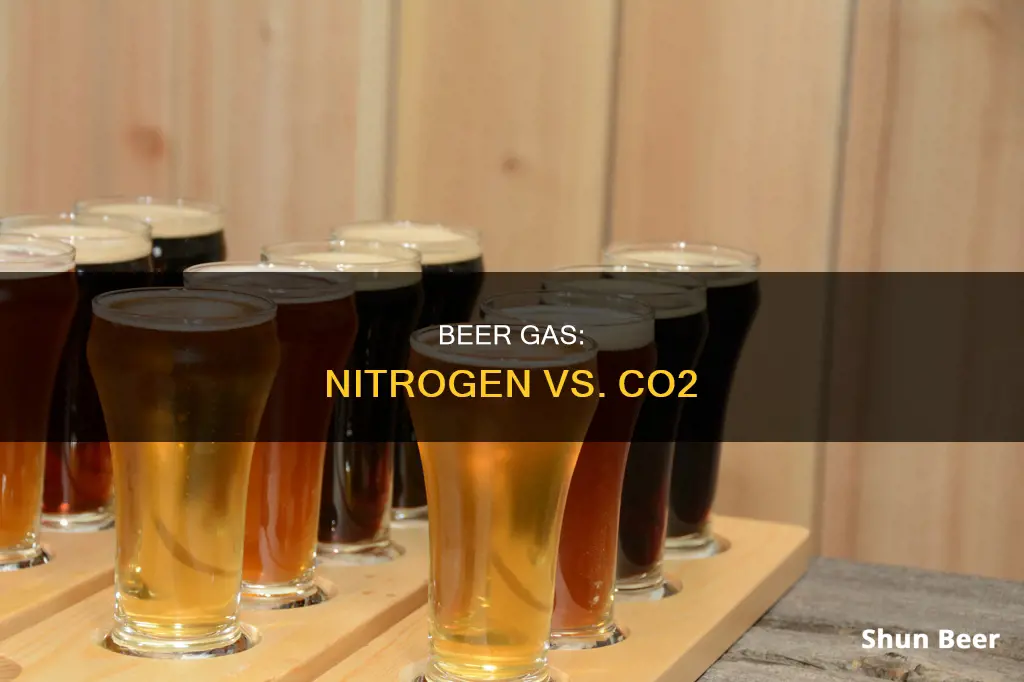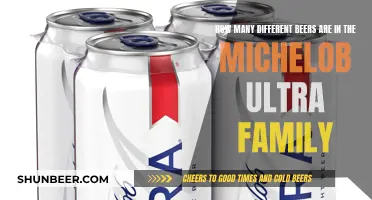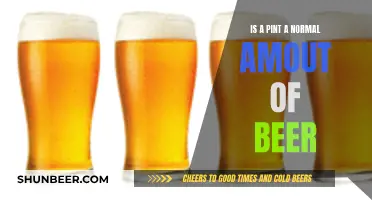
The use of nitrogen and carbon dioxide (CO2) in the brewing process creates distinct differences in the texture, taste, and appearance of beer. CO2 is the industry standard for beer carbonation, giving beer its signature fizz and bite. Nitrogen, on the other hand, produces a smoother, creamier mouthfeel with smaller, denser bubbles, resulting in a cascading effect when poured. While CO2 accentuates the sharpness and brightness of certain flavours, nitrogen mellows out and softens the flavour profile.
What You'll Learn

CO2 is the industry standard, used for its bite and tang
CO2 is the industry standard for beer carbonation. It is readily available and well-tested for craft beverage purposes. Brewers add priming sugar to the wort when they bottle, which produces CO2 in the bottle. The gas is also pumped into kegs and kept at pressure to carbonate beer and give it a foamy texture. CO2 brightens up the body of the beer with bubbles that contribute to aroma, bite, and tartness. It also leaves a carbonic bite on the tongue and sides of the drinker's mouth. This bite is caused by carbonic acid, which is created when CO2 is dissolved into an aqueous liquid. The bubbles of CO2 also interact with the pain receptors in the mouth, creating a pleasurable sensation.
CO2 is used to remove air and protect the product from oxidation, ensuring good taste, mouthfeel, quality, and shelf stability. It is often transported as a cryogenic liquid, which requires trailers and railcars for transportation. CO2 manufacturers should routinely test feed gas sources for compositional changes and monitor the quality throughout the production process. Storage and trans-fill depots should also have purity monitoring systems to screen incoming lots for quality.
Standards of purity are controlled by various regulatory bodies such as the Compressed Gas Association (CGA), International Society of Beverage Technologists (ISBT), European Industrial Gases Association (EIGA), and the FDA in the U.S. For example, the EIGA states that Food Grade CO2 should be at least 99.9% pure. Brewers play a role in ensuring their CO2 supply is free from contaminants and appropriately handled in the brewery.
Explore the Difference Between Ales and Lagers in Beer
You may want to see also

Nitrogen is less soluble, creating a smoother, creamier mouthfeel
Nitrogen is less soluble than carbon dioxide (CO2), which means it doesn't dissolve in beer to create carbonation in the same way. Instead, nitrogen is used to push beer out of the keg, maintaining the existing carbonation level. This results in a smoother and creamier mouthfeel and less carbonation overall. The nitrogen bubbles are smaller and denser, creating a thick, creamy head.
The smaller bubbles produced by nitrogen are less prickly on the tongue, leading to a soft and smooth drinking experience. This is in contrast to the sharper, more effervescent qualities of CO2-carbonated beers, where the bubbles are larger and rise quickly, contributing to the classic beer foam and foamy head.
Nitrogenated beers have a unique mouthfeel and smoothness. They are less carbonated and have a creamier, smoother texture—often described as velvety or silky. The difference in solubility between nitrogen and CO2 means that a keg or bottle pressurised with CO2 will have more gas dissolved in the beer, resulting in larger bubbles and a sharper taste.
The use of nitrogen in beer is a relatively recent development, with nitrogen first being introduced as an alternative to CO2 in the mid-20th century, mainly in stouts like Guinness. Brewers use a mix of nitrogen and CO2, typically with a ratio of 70% nitrogen and 30% CO2, as pure nitrogen does not carbonate beer in the same way and would result in flat beer.
Beer vs Pale Ale: What's the Difference?
You may want to see also

CO2 is pumped into kegs to create a foamy texture
CO2 is an acid, which gives beer a tangy bite and a light, dry texture. The bubbles interact with the pain receptors in the mouth, creating a pleasurable sensation. It also has a brightening effect on the body of the beer, enhancing the perceived sharpness and brightness of certain flavours.
CO2 is pumped into kegs and kept at pressure to carbonate the beer and give it that foamy texture. It's the industry standard for beer carbonation and is used in most draught beer systems. It's highly soluble in water-based liquids, so it easily dissolves into the beer to create carbonation. However, too much CO2 can over-carbonate the beer and alter its flavour.
The use of CO2 in beer goes back to the earliest days of brewing, when carbonation was a natural byproduct of fermentation. As yeast consumed sugars, they produced alcohol and carbon dioxide, giving beer its natural fizz. In modern times, brewers began to experiment with controlled carbonation by injecting CO2 directly into the beer to achieve a consistent level of fizziness.
Beer Carbonation: CO2 Content Varies by Brew
You may want to see also

Nitrogen is used to push beer out of the keg without over-carbonating it
Nitrogen is typically used with beers that are intended to be less carbonated and have a smoother mouthfeel, such as stouts or nitro cold brew coffee. The nitrogen helps to create a cascading effect when poured, resulting in a thick, creamy head.
The use of nitrogen in beer is a relatively recent development, gaining prominence in the mid-20th century as an alternative to CO2. Nitrogen is often used in stouts, such as Guinness, as it produces a creamier, smoother draft beer with a distinctive cascading pour. This is in contrast to the sharper, more effervescent qualities of CO2-carbonated beers.
Nitrogenated beer is created by using a mix of nitrogen and CO2, typically around 70% nitrogen and 30% CO2. The beer is then forced through tiny holes in a specially designed tap, which facilitates the formation of small, tight bubbles characteristic of nitrogenated beer.
The use of nitrogen in beer offers a unique set of qualities, transforming the texture and presentation of the beer. It provides a velvety, almost silky texture, with smaller bubbles that are less prickly on the tongue, leading to a soft and smooth drinking experience.
Beer Carbonation: Why the Fizz Differs
You may want to see also

CO2 is cheaper and more readily available than nitrogen
Carbonation is an essential part of the beer-making process, and brewers have a choice between carbon dioxide (CO2) and nitrogen. CO2 is the traditional option and is the most common gas used in beer production. It is the industry standard, so it is readily available and well-tested for craft beverage purposes. It is also naturally produced during the fermentation process.
However, nitrogen has gained popularity in recent years, especially for stouts and porters. Nitrogen is cheaper than CO2, especially with onsite generation, which can pay for itself in less than two years. Onsite generation also means that producers do not have to wait for deliveries, and they can be more efficient and reduce their carbon footprint. Nitrogen is also more readily available, as it makes up 78% of the air we breathe.
Nitrogen is less soluble than CO2, so it does not dissolve into the beer to create carbonation in the same way. Instead, it is used to push the beer out of the keg, maintaining the existing carbonation level. Nitrogen is perfect for beers that are intended to be less carbonated and have a smoother, creamier mouthfeel.
Beer, Ale, Lager, Stout: What Sets Them Apart?
You may want to see also
Frequently asked questions
Nitrogen and CO2 are two gases commonly used to dispense beer on tap. While they serve the same purpose, they have different effects on the beer, resulting in different tastes and mouthfeels.
CO2 (carbon dioxide) is a non-toxic gas that is produced by yeast during fermentation. It is a naturally occurring gas and is the most commonly used gas for dispensing beer on tap.
CO2 carbonates the beer and makes it fizzy. It also makes beer more acidic (lowers the pH), creates small bubbles, and enhances aroma and flavour.
Nitrogen is another gas used to dispense beer on tap. It is less soluble than CO2 and creates smaller bubbles that rise more slowly to the top of the glass, resulting in a creamy and smooth mouthfeel.
Nitrogen beers have a less acidic, thicker, and more full-bodied taste than CO2 beers. They also have a smoother and creamier mouthfeel due to the smaller bubbles created by nitrogen.







